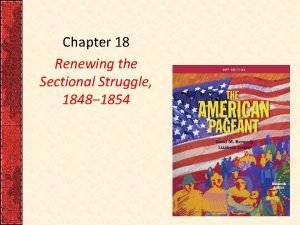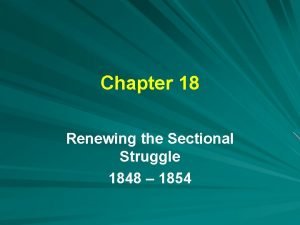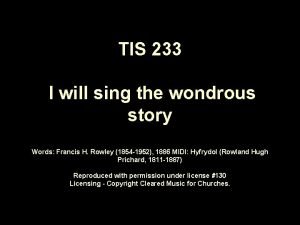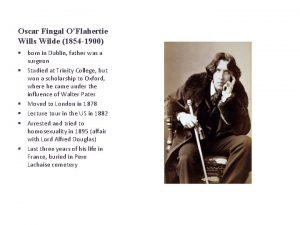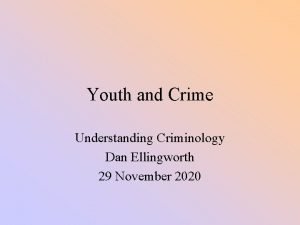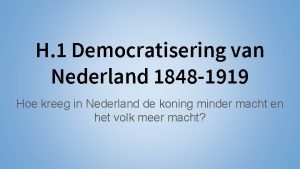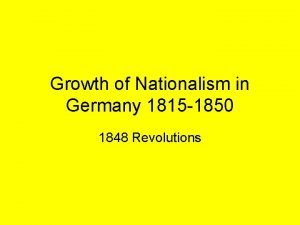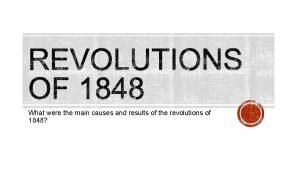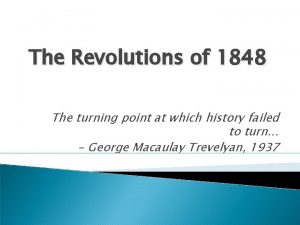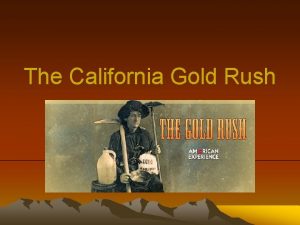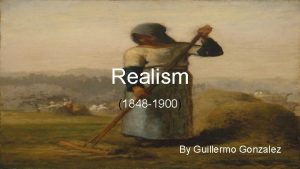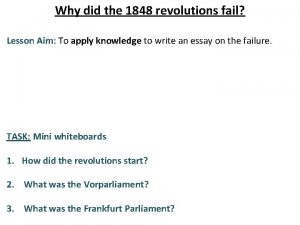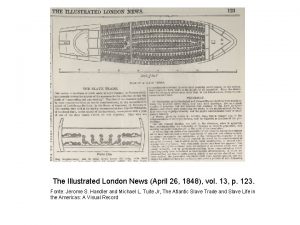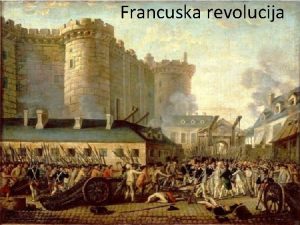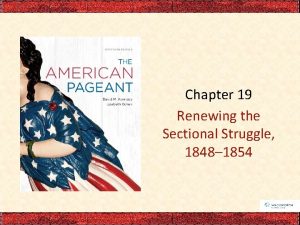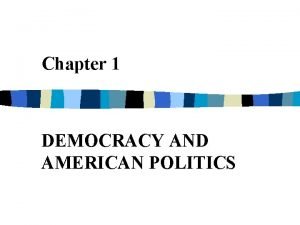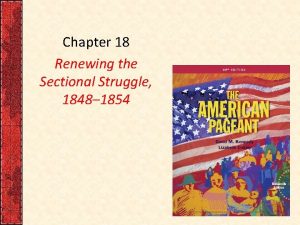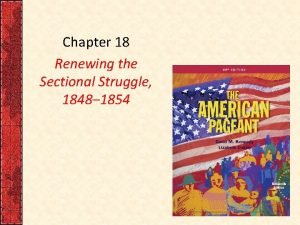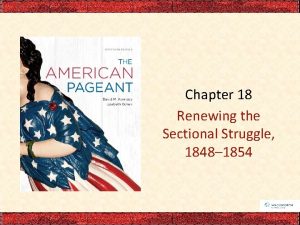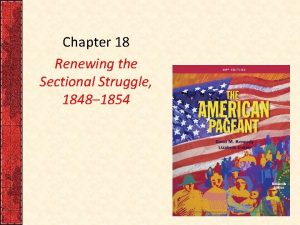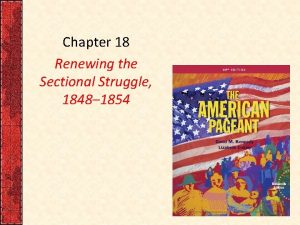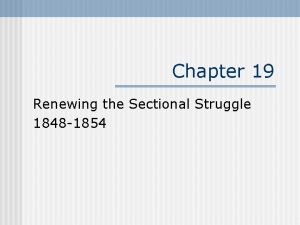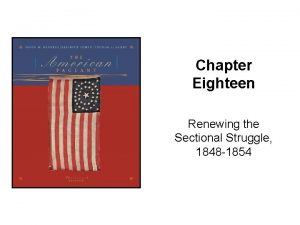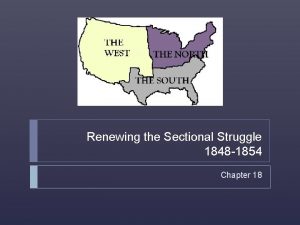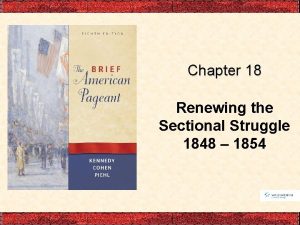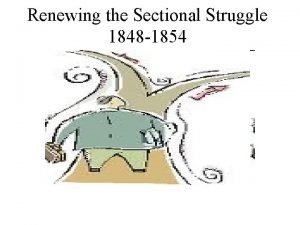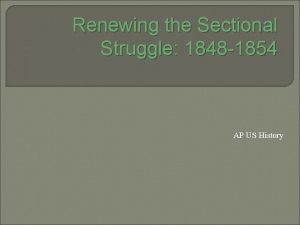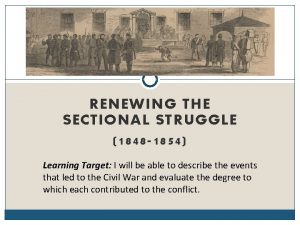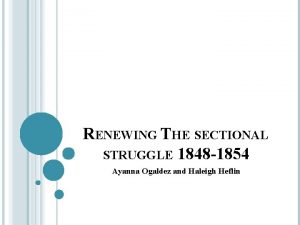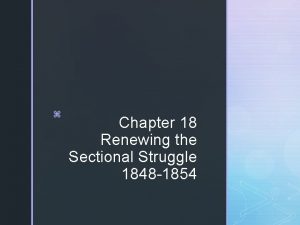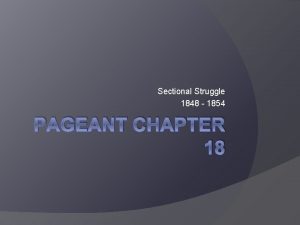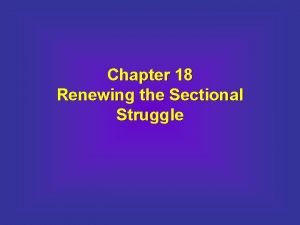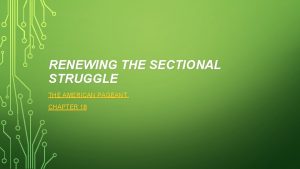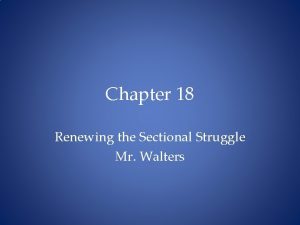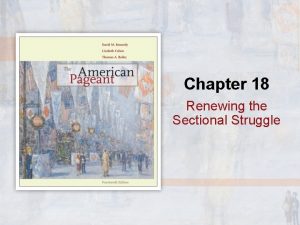Chapter 18 Renewing the Sectional Struggle 1848 1854




































- Slides: 36

Chapter 18: Renewing the Sectional Struggle, 1848 – 1854 p. 390 – 409

Sectionalism and the US • From the very beginning, the US had developed along sectional lines politically, economically, and socially • Sectionalism, exacerbated by the slavery issue in the first ½ of the 19 th century will be the main factor for the US’s going to war with itself by the 1860’s – Sectionalism, without slavery, still would have existed in the US – Sectionalism, with the slavery controversy, will break the nation in two

Sectionalism and the US • Sectionalism, and examples of its growth, is the overarching topic of Chapters 16 -19 – Chapter 16 • The growth and dependence on slave labor in the South • The growth of the abolition movement in the North – Chapter 17 • Manifest destiny and a war for the expansion of slavery? – Chapter 18 • • Political parties sectionalize Changing of the guard in Congress Compromise of 1850 The trans-con RR – Chapter 19 • The end of compromise and beginning of war

1840 1850 The U. S. gained vast territories as a result of the victory in the Mexican American war. The issue of slavery in these new areas would lead directly to the Civil War. 4

Election of 1848 • national pol parties = unity • keep unity means to ignore slavery issue • Democrats – Gen. Lewis Cass – Silent on slavery – but believes answer in popular sovereignty – Democratic self determination – compromise • Whigs – Z Taylor – Winner – p. 382 – I’m getting this tattooed on my neck! – Dodged slavery, not committed to extension, owned slaves • Free Soil – – – Van Buren Wilmot Proviso, improvements, free land Didn’t hate slavery, just idea of sharing Mexican Cession w/ African Americans Slavery destroys whites chances of owning land Free soil would solve problem

Free Soil Party In 1848, at Buffalo New York, a gathering of anti-slavery members of the Whig Party and the Liberty Party established the Free-Soil Party. The new party opposed the extension of slavery into the new western territories. In the 1848 presidential election they ran former president Martin Van Buren who polled 10 per cent of the vote. He split the traditional Democratic support and enabled the Whig candidate, Zachary Taylor, to win. By 1852 the Free-Soil Party had 12 congressmen but did poorly in the presidential election. Two years later, remaining members joined the Republican Party. The existence of the party alarmed southerners who saw it as a threat to their culture and way of life Slogan of the Free Soil Party 6

Election of 1844 Note the growth in the popular vote for the antislavery parties, Liberty Party in 1844 and Free Soil Party in 1848. Election of 1848 7

CA Gold • early 1848 – thousands migrate to strike it rich – few do • Gold Rush also creates rush to bring in as state • white, single, uneducated, unemployed, criminals, prostitutes – song lyrics and Emerson quote, p. 383 • much crime, little enforcement • $ from supplying miners, hotel, restaurant, saloon • apply as Free in 1849 • Interesting place names – map p. 383

The divisive issue of new states admission into the Union reached a crisis point when events in newly acquired California caused a population boom. 9

California population Growth 10

South in 1850 • • California admittance causes compromise relatively well off – – – – • BUT – – large share of US leadership southern pres – ZT Majority of cabinet Majority of SC = senate cotton prices high little threat to slavery where it was 15 slave states could veto Balance tipping w/ CA Slave territory short NM and UT possibly free – CA setting example Abolition movement gaining steam in N – UNDERGROUND RAILROAD – THREAT? • 1000/yr small – principle • N holier than thou, breaking law • Need better Fugitive Law


Escaping from slavery: the Underground Railroad Neither "underground" nor a "railroad, " this informal system was a loosely constructed network of escape routes which originated in the South, intertwined throughout the North and eventually ended in Canada. Escape routes were not just in the North, but also extended into Western territories, Mexico and the Caribbean. From 1830 to 1865, the Underground Railroad reached its peak as abolitionists and sympathizers who condemned slavery helped large numbers of slaves win their freedom. Workers on the Underground Railroad did more then speak out against slavery they helped slaves get out of slavery. There was no formal organization. It relied upon individuals cooperating to help the enslaved escape to freedom. 13

Henry "Box" Brown escaped slavery in 1848 by having himself nailed into a small box and shipped from Richmond to Philadelphia. He later became a well-known speaker for the Anti-Slavery Society. In 1851 he wrote his autobiography, Narrative of the Life of Henry Box Brown. 14

It wasn’t a railroad but a network of safe houses and sympathetic citizens who would aid runaway slaves. 15

Issues Raised by the debate over the Compromise of 1850 How will the issue of slavery be resolved in the new territories taken from Mexico? California has petitioned Congress to enter the Union as a free state. If they enter it will upset the Missouri Compromise, the balance between slave states and free states. There was a dispute over land: Texas claimed that its territory extended all the way to Santa Fe. The nation's capital Washington, D. C. was home to the largest slave market in North America and many wanted it stopped. 16

California Concerns Create Calls for Compromise in Congress • • Old Guard – Clay, Calhoun, Webster – PRESERVE UNION Clay – proposes/defends compromises – N and S concessions, N yield on fugitive law • • Calhoun – leave alone, return slaves, give S rights as minority, restore balance, 2 presidents – DIES Webster – Seventh of March Speech – Urge concessions to S, inc FSL – Slavery extension – no need to make laws – plantation ag not profitable in Mexican Cession, so no slavery (wrong about CA) – Helps turn N to compromise • Young Guard – Newer leaders from N – NOT INTERESTED IN PRESERVING UNION – • • “Fire Eaters” in the S Taylor – would veto compromise – but DIES Millard Fillmore assumes – colorless, conciliatory – Signs compromises from congress • N and S come to accept, 2 nd Era of Good Feelings – bury slavery

Fire Eaters A term applied by Northerners to proslavery extremists in the south in the two decades before the Civil War. Edmund Ruffin, Robert Toombs , and William L. Yancey were the most outspoken of the group. Beginning in 1850, at a convention held in Nashville Tennessee, the “fire-eaters” urged southern secession from the northern free states The Compromise of 1850 delayed their goal of a separate slave holding nation for ten years. They were a constant force working to break up the United States. William L. Yancey Robert Toombs 18

The Compromise of 1850 had five sections Old Senate chambers where the debate took place 1. The territories of New Mexico, Nevada, Arizona, and Utah would be organized without mention of slavery. The decision would be made by the territories' when they applied for statehood. 2. California would be admitted as a free state. 3. Texas would relinquish the land in dispute but, in compensation, be given 10 million dollars to pay off its debt to Mexico. 4. The slave trade would be abolished in the District of Columbia, although slavery would still be permitted. 19

The fifth part of the Compromise of 1850, the Fugitive Slave Law, caused a storm of protest and would be a catalyst for Civil War eleven years later. 1. It clothes any ruffian who may be commissioned to act in his new and infamous office of Slave-Catcher, with magisterial and judicial authority. 2. It commands and requires good citizens to aid in this heartless and brutal business, imposing the work of bloodhounds upon them. 3. It authorizes such kidnappers and rascals as may choose to do so, to arrest o seize persons without “due process of law”. 4. It jeopardizes the liberty of every colored person, by requiring merely a “general description” and by casting out the evidence of the person arrested. 5. It seeks to annul the writ of Habeas Corpus which tends to secure justice and liberty by delivering a person from false imprisonment, or by removing a case from one court to another. 6. It imposes excessive fines. 7. It denies the citizen a Jury Trial, where his liberty, and perhaps his life, is at stake. A critique of the law from an anti-slavery perspective 20

What the Fugitive Slave Law ordered ØFederal commissioners were appointed and given authority to issue warrants, gather posses, and force citizens to help them catch runaway slaves under penalty of a fine or imprisonment. ØAccused runaways were denied both a jury trial and the right to testify in their own behalf. They could be sent to the South on the basis of a supposed owner's affidavit. Ø Also working against the accused’s ( runaway or free) chances for freedom was the fee to be paid to the commissioners to decide each case: they received ten dollars for returning the fugitive to the claimant, five dollars if they freed the person. ØThe law, made all personal liberty laws null and void. A slave owner or slave catcher could claim fugitives simply by seizing a Black person who fit the description of the runaway and bringing him/her before a federal judge. The judge decided the identity of the fugitive, based entirely on the testimony of the slave owner or slave catcher. ØAny US marshal who refused to act under the law was fined $1000, and any person "obstructing arrest of [said] fugitive, harboring fugitives, or concealing them" was fined up to $1000 and could serve up to six months in prison. 21

Compromise of 1850 • • • North – CA = free – Territory disputed b/t TX and NM given to NM – Prohibit slave trade (not slavery) in DC South – Mexican Cession – NM and UT – pop sov – TX gets $10 million from feds – Fugitive Slave Law of 1850 Who Wins? – N – CA tips balance in Sen – NM and UT – pop sov – but higher law to free S gets FSL – Couldn’t testify – Denied jury trial – Fed commissioner gets $5 if freed, $10 if returned – N’s who aid liable to fines/jail, join slave catchers FSL – chain reaction in N – Moderates driven to abolition – Underground RR steps up – N mobs rescue slaves – Personal Liberty Laws; states make illegal to enforce FSL – Spirit of antagonism in N – bolster resistance

Protests and political action against the Fugitive Slave Law Several Northern states passed additional “personal liberty” laws designed to counter the Fugitive Slave Law. 23

An emotional condemnation of the Fugitive Slave Act. The print shows a group of four black men--possibly freedmen-ambushed by a posse of six armed whites in a cornfield. One of the white men fires on them, while two of his companions reload their muskets. Two of the blacks have evidently been hit; one has fallen to the ground while the second staggers, clutching the back of his bleeding head. The two others react with horror. 24

Whigs – Doom in 1852 • Election of 1852 – D’s – Pierce – NH - WINNER • Prosouthern northerner – OK to S D’s – Winfield Scott – not Fillmore • Split – N W’s didn’t like accept of Compromise; S doubts loyalty; Scott war hero • Significance – End of Whig party – Eclipse of national, rise of sectional parties

Southern Expansion • Mexican War, CA = Manifest Destiny • Manifest Destiny reinterpreted by Southern Democrats to push further south to extend slave states – Cuba • Large pop slaves • Carve into states, maintain political balance • Spain refuses $100 million • President Pierce – Ostend Manifesto (not a smart move) – $120 million; if Spain refused and their ownership threatens US interests, US can just take Cuba (Monroe Doctrine) – Plan leaks, northerners rise against; Pierce drops this idea quickly


Filibusters (one who engages in private, unauthorized and irregular warfare against any state) In an attempt to gain more slave territory, as in Kansas, individuals known as filibusters raised private armies and attempted to take over territories in Mexico and Central America. The most well known filibuster was William Walker. With an army of 58 mercenaries in 1855, he invaded Nicaragua and, taking advantage of civil unrest, managed to have himself declared President. One of his first acts was to make slavery legal. His “rule” lasted a year when he was forced to flee. He tried again but ended up getting shot. All filibustering expeditions ended in failure and this method of increasing slave territory was abandoned. 28

US Railroad • • • CA, OR 8 k mi from DC Transcon RR only solution – physically tie country together N or S for terminus? – only 1 due to expense Favored section would grow in wealth, population, influence S – best route just S of Mex border – – • • Gadsden Purchase - $10 million at southern end of New Mexico terr. Easier to build, smaller mts, organized area (troops) N – wants RR thru Nebraska – organize Neb Kansas-Nebraska Scheme (Act) – – – 1854 – Stephen Douglas – IL terminus in Chicago plan to enlist support of S cut Neb into 2 territories – Kan and Neb determine slavery by pop sov • • – – – Kan – next to Missouri, become slave Neb – next to Iowa, free contradicts Missouri Comp of 1820 – would have to repeal MC of 1820 S in favor, Douglas pushes through Failed to see deep N feeling about issue – breach of faith

Senator Douglas, the Democratic Senator from Illinois and Chairman of the Committee on Territories, introduced a bill in early 1854 to reorganize the territories. Douglas’s motives have been called into question as he had invested heavily in western lands and had a stake in getting the terminus of the planned transcontinental railroad located in Chicago Illinois. He was also interested in running for president and thought the publicity generated from this bill would help him achieve his goal. His Kansas Nebraska Act was one of the great blunders in all U. S. political history and started a chain of events that ended in the Civil War. 30

1. The Kansas-Nebraska Act divided the land west of Missouri into two territories, Kansas and Nebraska. 2. To deal with the slavery issue Douglas included the concept of popular sovereignty which would allow the settlers of the new territories to decide if slavery would be legal. He did this to garner southern support for the his bill. 3. Douglas miscalculated thinking that by leaving the issue of slavery up to the citizens of the new territories it would remove slavery from the national debate. 4. Essentially the Kansas-Nebraska Act repealed the Missouri Compromise of 1820 making slavery legal where it would have been outlawed. This enraged anti-slavery citizens. 5. After months of debate, the Kansas-Nebraska Act passed on May 30, 1854 signed into law by President Franklin Pierce. Whether slavery shall go into Nebraska, or other new territories, is not a matter of exclusive concern to the people who may go there. The whole nation is interested that the best use shall be made of these territories. We want them for the homes of free white people. This they cannot be, to any considerable extent, if slavery shall be planted within them. Slave States are places for poor white people to remove FROM; not to remove TO. New free States are the places for poor people to go to and better their condition. For this use, the nation needs these territories. Abraham Lincoln, 1854 31

The status of slavery in the territories before the Kansas Nebraska Act of 1854 Slavery not allowed under Missouri Compromise Slavery allowed under Missouri Compromise of 1820 line 32

The status of slavery in the territories after the Kansas Nebraska Act of 1854 Slavery now allowed under the Kansas Nebraska Act. It was not allowed under the Missouri Compromise of 1820. Slavery allowed under Missouri Compromise and the Kansas Nebraska Act. Missouri Compromise of 1820 line 33

the Kansas-Nebraska Act had a profound impact on the course of U. S. history vthe reopening of the slavery question in the territories v“Bleeding Kansas”, open warfare in the territory between pro and anti-slavery forces vpolitical parties realigned along sectional lines vthe Democrats became a southern proslavery party vthe Whig Party, which had opposed the Act disappeared in the South and was fatally wounded in the North va new party emerged, the Republican which gathered in anti-slavery Whigs and Democrats and was seen as a mortal danger to pro-slavery forces 34

The Republican Party is formed Ripon Wisconsin The passage of the Kansas-Nebraska Act of 1854 led to the creation of the Republican Party. It split the Democrats and the Whig party and unified abolitionist factions. Two “Anti-Nebraska” meetings were held in Ripon, Wis. , on Feb. 28 and Mar. 20, 1854. Groups of abolitionists, Free Soilers, Democrats, and Whigs formed the Republican party at these meetings. The new party was an immediate success. In the 1854 congressional elections, 44 Republicans were elected and several other Republicans were elected to the Senate and to various state houses. 35

K-N Act significance – Future comp w/ S difficult – W/out would be conflict – FSL completely ignored in N – Both see less they can live with – Antislaveryites – increase – D’s shattered – Republicans begin • In Midwest, rushes east • Whigs (Lincoln), D’s (N), Free Soilers, Know Nothings, others against K-N • Elect Speaker w/in 2 yrs • Second major party – purely sectional
 Chapter 18 renewing the sectional struggle
Chapter 18 renewing the sectional struggle Chapter 18 renewing the sectional struggle
Chapter 18 renewing the sectional struggle Pure heart mean
Pure heart mean 1891-1854
1891-1854 1854
1854 Born in dublin 1854
Born in dublin 1854 Wood despatch 1854
Wood despatch 1854 Youthful offenders act 1854
Youthful offenders act 1854 Leto 1848 leto revolucij
Leto 1848 leto revolucij Leto 1848 in slovenci
Leto 1848 in slovenci Leto 1848 in slovenci
Leto 1848 in slovenci Nederland en belgie
Nederland en belgie Why did the italian revolution of 1848 fail
Why did the italian revolution of 1848 fail Bernhard bolzano
Bernhard bolzano Austrian empire 1848
Austrian empire 1848 Austrian empire 1848
Austrian empire 1848 January 24th 1848
January 24th 1848 Revolucije u europi 1848
Revolucije u europi 1848 Realism (1848–1900)
Realism (1848–1900) 1848 katonadalok
1848 katonadalok Why did the 1848 revolutions fail
Why did the 1848 revolutions fail 1848 revolution germany
1848 revolution germany Anul 1848 in europa
Anul 1848 in europa Revolution 1848 verlauf
Revolution 1848 verlauf Revolucije u evropi
Revolucije u evropi Francúzska revolúcia 1848
Francúzska revolúcia 1848 Emancipace žen 1848
Emancipace žen 1848 Quadrilatero austriaco
Quadrilatero austriaco Großdeutsche lösung
Großdeutsche lösung Illustrated london news 1848
Illustrated london news 1848 Francuska revolucija
Francuska revolucija Struggle chapter 19
Struggle chapter 19 Struggle chapter 3
Struggle chapter 3 Struggle chapter 1
Struggle chapter 1 Hình ảnh bộ gõ cơ thể búng tay
Hình ảnh bộ gõ cơ thể búng tay Ng-html
Ng-html Bổ thể
Bổ thể
